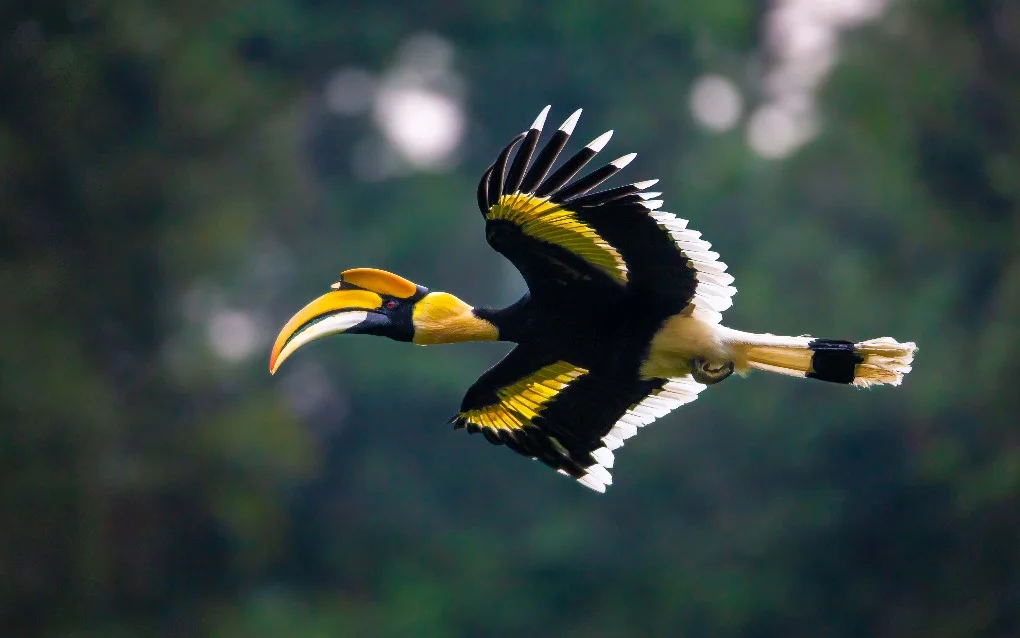
As a bird enthusiast, I am thrilled to share my knowledge and experience with fellow birdwatchers planning a trip to India to spot the beautiful Great Indian Hornbill. These beautiful creatures are also called concave-casqued hornbill, great Indian hornbill, and great pied hornbill. Here are some frequently asked questions and tips to help you plan your birding adventure.
Hornbills in India: Frequently Asked Questions
Q: What is birding in India like?
A: India is an excellent place for birdwatching, though it doesn’t have the expected endemicity to its size. With a diverse range of habitats and bird species, India is home to more than 1300 species of birds.
Q: Why is the Great Indian Hornbill (Great Hornbill) one of the most beautiful hornbills in the world?
A: This may be my personal opinion. Nonetheless, The Great Hornbill is considered one of the most beautiful hornbills in the world due to its unique physical characteristics. It has a bright black and yellow casque on top of its massive bill, and both male and female birds have distinctive features such as red or white eyes and “eyelashes.” Additionally, their heavy rumbling sound when they fly is a unique feature that sets them apart. Finally, though the sky is the limit, they are monogamous. Interesting.
Q: How many species of hornbill are there in the world?
A: Around 60 species of hornbill are in the world, with nine species found in India. The great Indian Hornbill is the state bird of Kerala.
Q: What are the specialities of Great Hornbills?
A: Great Hornbills are known for their large size, with a wingspan of 130 cm and an average length of 120 cm. They are also unique in their nesting behaviour, as they seal the female inside the nest during the breeding season. Additionally, their loud calls and heavy flapping sound( Like a hoovering helicopter) while flying are characteristic features of the Great Hornbill.
Best Locations In India To See Great Indian Hornbills
Q: Where are all the Great Indian Hornbills found in India?
A: Great Indian Hornbills are found in forested areas in the Indian subcontinent and Southeast Asia. Western Ghats of Kerala, and Assam’s Kaziranga National Park, are the hotspots, and there are few sighting reports from Arunachal Pradesh, Nagaland, and Meghalaya.
Q: Which is the easiest place to find Great Hornbills?
A: Kerala and Assam are some of the best places to spot the Great Indian Hornbill. Nelliampathy and Thekkady are recommended locations in Kerala, while Kaziranga National Park is a good spot in Assam. On my recent trip to Kaziranga, I saw a pair making a nest on a tree about 10 meters above the ground. It was a quite amazing sight. It is advised to hire a local guide who knows the area and can help you spot the bird.
7. How can I find a good birding guide in India?
There are many experienced tour guides and birding tour operators in India. I use the services of Dhanish Trogon for my birding needs in India. Another option is to connect with www.nestindiabirding.com, which has many good birding guides all across India.
In conclusion, India is a birding paradise, and the Great Indian Hornbill is undoubtedly one of the most beautiful and fascinating bird species to spot. You will surely have a memorable and successful birding trip in India by visiting the recommended locations and hiring a local guide. Happy birding!
Lesser Known Facts about Hornbills
The hornbills are an amazing group of birds due to their unique appearance and interesting behaviours. This article will provide an overview of the scientific family names of hornbills, the number of species, their geographic distribution, diet, and some notable traits of these animals.
Hornbills are a unique species of birds known for their distinct appearance and captivating behaviours. This article will explore the scientific names of the hornbill family, the number of species within the family, their distribution, diet, and some exceptional characteristics of this avian species.
Hornbills: Distribution and Habitats
Hornbills have the ability to inhabit various types of habitats, which include rainforests, woodlands, savannas, and deserts. They can be found in many countries, such as India, Indonesia, Malaysia, Thailand, Africa, and the Philippines. These birds can adapt and survive in both tropical and subtropical climates.
Diet and Feeding Habits of Hornbills :
Hornbills have a broad distribution, occupying various habitats, including rainforests, woodlands, savannas, and deserts. They can be found in several countries, such as India, Indonesia, Malaysia, Thailand, Africa, and the Philippines. These birds are adaptable and can survive in different climate zones, ranging from tropical to subtropical.
Unique Characteristics of Hornbills:
Prominent Bills: One of the most distinctive features of hornbills is their large, curved bills. The size and shape of the bill vary among species, with some having long, curved bills while others possess shorter and more robust ones.
Casque: Another remarkable feature is the casque, a hollow structure on top of the bill. The casque serves multiple purposes, including amplifying the bird’s call, attracting mates, and protecting during territorial conflicts
Monogamous Behavior: Hornbills are known for their strong monogamous bonds. Mated pairs engage in cooperative breeding, where the male helps the female during incubation and chick-rearing inside a cavity. The female seals herself inside the nest, leaving only a narrow slit for the male to pass food to her and the chicks.
Which is the most colourful Hornbill in the World?
The Rhinoceros Hornbill (Buceros rhinoceros) is the most beautiful bird. I have had the pleasure of seeing them in Malaysia and Borneo. This bird is native to Southeast Asia and has a striking appearance with black feathers and white belly patches. Its bill is a bright yellow colour and has a yellow casque on top with a reddish base. It truly is a magnificent bird that captivates observers with its vibrant plumage.
What is the rarest Hornbill in the World?
The Helmeted Hornbill (Rhinoplax vigil) is considered the rarest Hornbill in the World and is classified as critically endangered. It inhabits the rainforests of Southeast Asia, particularly Thailand, and is known for its solid casque, which is highly valued in the illegal wildlife trade. Due to this demand, the population of Helmeted Hornbills has significantly declined, making conservation efforts vital for their survival. I am still waiting to see one in the Wild.

